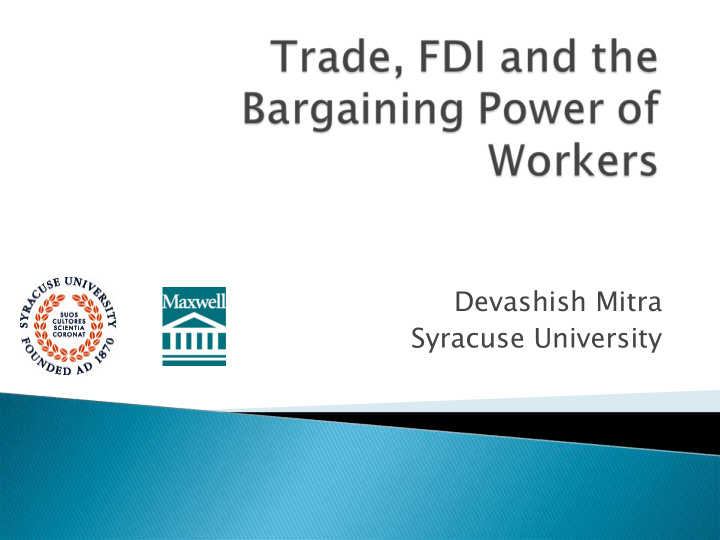



Devashish Mitra Syracuse University
Through it, affects workers’ bargaining power. Trade increases labor-demand elasticity (its absolute value) substitution effect: (1- s) σ ◦ scale effect: s η ◦ (Rodrik, 1997 and Slaughter, 2001)
• Rodrik (1997) – Larger wage and employment volatility from given volatility in productivity. • What about productivity growth? – Larger incidence of non-wage labor costs on labor. – Reduction in the bargaining power of workers. The above are related.
• Trade makes it easier for firms and consumers to substitute the services of domestic workers with those of foreign workers (Rodrik, 1997). • Theoretical work by Mezzetti and Dinopoulos ( JIE , 1991): The threat of offshoring or imports of inputs can yield significant increase in firms’ profits.
• Slaughter ( JIE , 2001) – mixed evidence for the US using 4-digit industry-level data • Krishna, Mitra and Chinoy ( JIE , 2001) – no statistically significant effect of trade reforms, using plant level data for Turkey. • Hasan, Mitra and Ramaswamy ( REStat , 2007) – support for hypothesis, using 2 digit industry-level data at the state level – evidence stronger for states with more flexible labor markets (labor laws) – after liberalization, using our CRS specification, elasticity went up from 0.38 to 0.52 on average for all states and from 0.64 to 0.8 for the flexible states • New study by Mine Senses (2008) – looks at the effect of outsourcing using US plant-level data – finds significant effects
• A rough test: Hasan, Mitra and Ramaswamy (2007) – Wage bill as a share of output was 21% lower in the period post 1991. – Wage bill as a share of VA was 19% lower in the period post 1991. – This can either be viewed as a rough test, or a test of the relative importance or strength of the effect relative to other effects • Stolper-Samuelson Effects • Destruction of markups (Levinsohn (JIE, 1993), Harrison (JIE, 1994) and Krishna and Mitra (JDE, 1998) • Work in progress by Ahsan & Mitra show that at the firm level the effects are somewhat different.
Brock and Dobbelaerre (2006): W = Wa+ [ β /(1- β )]*[R- WN]/N (A) N/R + β WN/R = (1- β )W a (B) (1) Estimate (A) for each industry using firm level data. Wa is sector-average wage. What is Wa? (2) Then regress these bargaining powers on trade related variables. Dumont, Rayp and Wileme ( OEP , 2006) find significant ◦ negative effect of trade and offshoring on bargaining power. Similar effects found for Belgium by Brock and ◦ Dobbelaerre ( RWE/WWA , 2006). Arbache (2004) finds the opposite effect for Brazil ◦ using data for a few years before and after their trade liberalization of 1990s.
Trade destroys supernormal profits or rents. Nothing to share or negotiate about through union ◦ bargaining Trade improves the threat point of employers. Thus, unions are no longer viable. Problem: Endogeneity of trade policy to unionization (not addressed by the following) Evidence Baldwin (2003): In the US, trade only marginally responsible for ◦ deunionization, relatively more responsible in the case of blue collar workers. Technological change and other unknown factors more ◦ responsible. Dreher and Gaston ( Kyklos , 2007): Similar results for 17 OECD countries during 1980-99 ◦ “Economic globalization” does not have a statistically significant impact on union membership.
More studies for developing countries Plant/Firm-level employment and wage data ◦ needed (matched employer-employee data ideal) Explore channels through which trade affects bargaining power. More work on the impact of trade on de- ◦ unionization, especially for developing countries Work on unionization using firm-level data ◦ Study the interactions between firm characteristics and trade in the determination of unionization of workers.
Explore whether results on the effects of trade on bargaining power are different with firm-level and industry-level data Look at composition effects ◦ Effects through entry and exit ◦ Firm heterogeneity (interactions with firm ◦ productivity or size) Worker heterogeneity ◦ Interaction between labor-market institutions and trade policy
Implications of the effect of trade on bargaining power For employment and unemployment (Dutt, Mitra ◦ and Ranjan, 2009 and Hasan, Mitra and Ranjan, 2009) For wage inequality ◦ For consumers (Can workers be better off as ◦ consumers?) More empirical and theoretical work needed ◦
Rana Hasan, Devashish Mitra, Pravin Krishna, Matt Slaughter, Mine Senses, Ellen Brock, Noel Gaston, Sabien Dobbelaire, Nina Pavcnik. Matched employer-employee datasets: Brazil (Muendler), France (Kramarz), Sweden (Fredrik Sjoholm), UK (Peter Wright & Richard Upward) etc Industry-level data – easily available
Recommend
More recommend